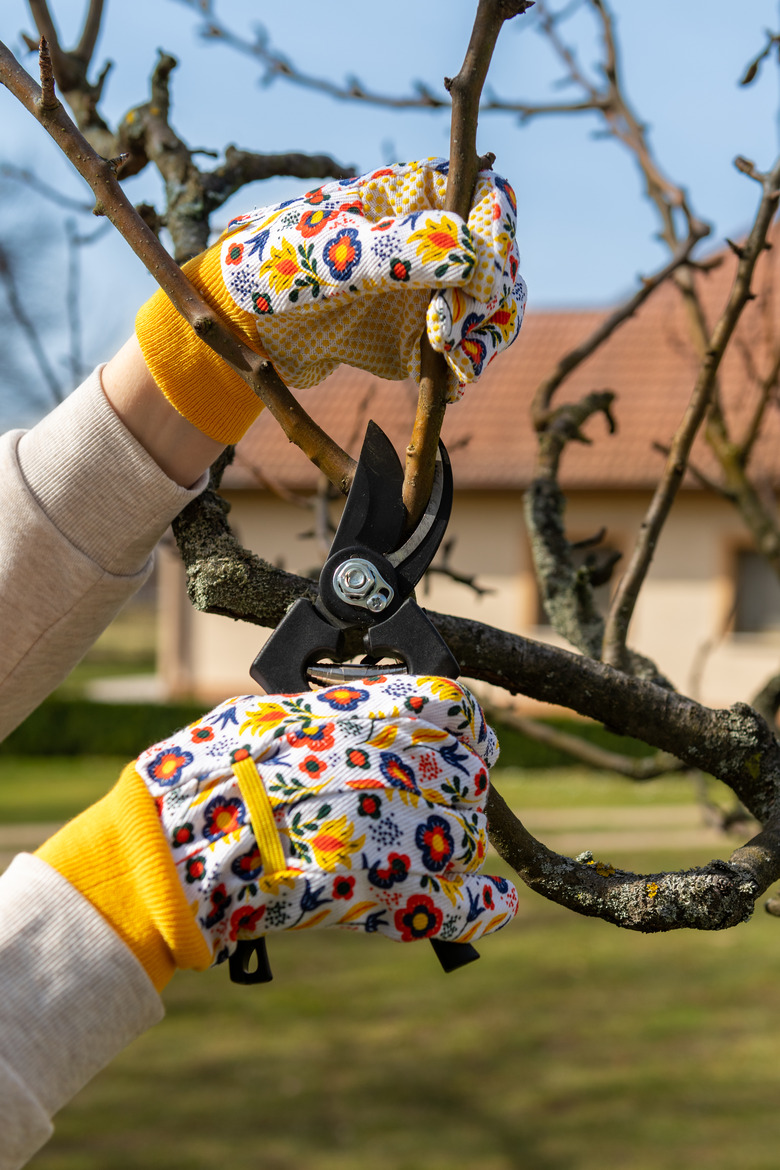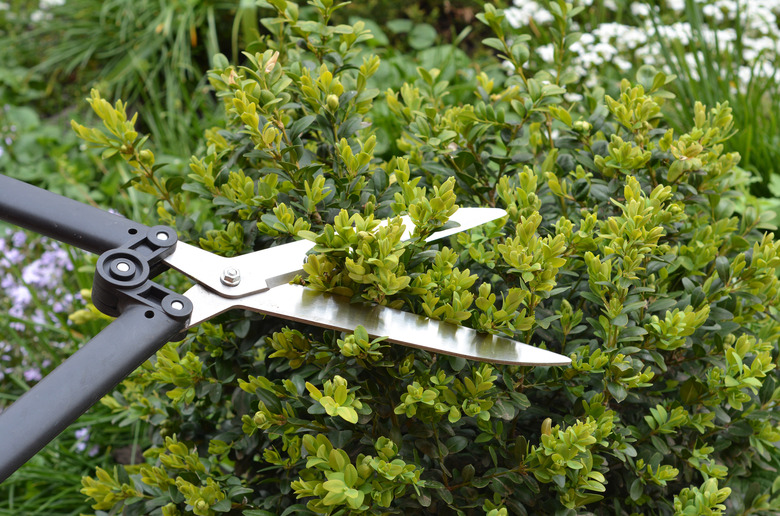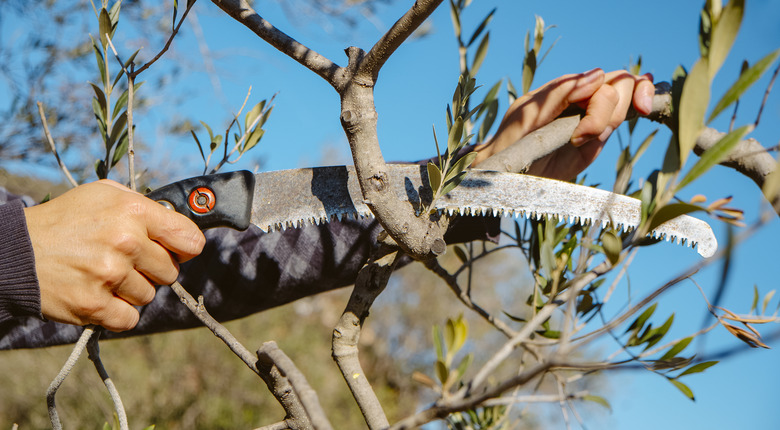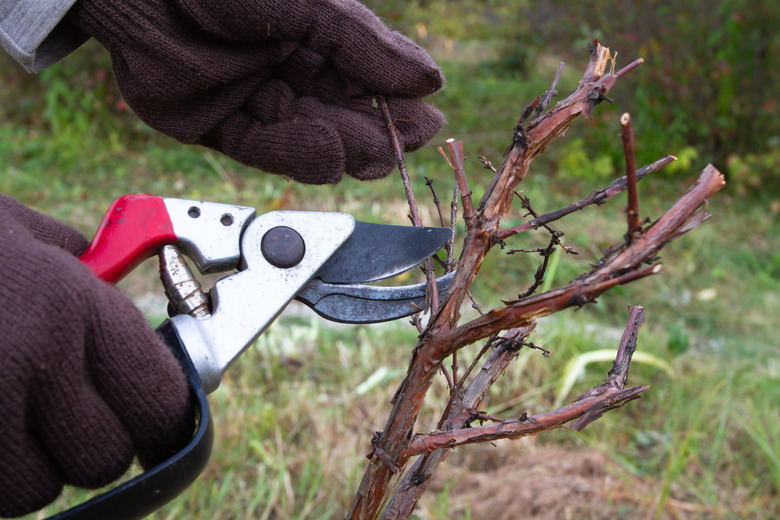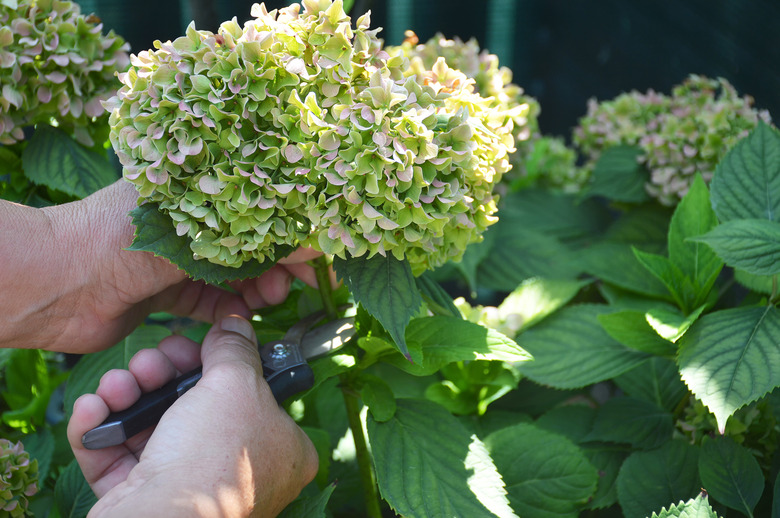How And When To Prune 50 Trees, Shrubs, And Flowers
If you're confused about the when and hows of pruning, you aren't alone. Each type of garden tree, shrub, and bush has its own pruning requirements. We've made it all easier for you by combining 50 of them into an easy-to-read chart.
What Is Pruning?
What Is Pruning?
You may think of pruning landscape plants as the equivalent of a haircut, required for appearance only. But that is just the beginning. While some pruning shapes plants to fit well within the landscape, trimming at the appropriate times can also encourage flowering and fruiting and even improve the plant's health.
Failure to prune doesn't result in the immediate demise of a tree or shrub, but it can limit its ornamental value, allow deadwood to choke off the plant's vitality, and reduce the yield of fruit and blossoms. Timing is key when pruning, and one might argue that pruning at the wrong time is worse than not pruning at all.
Pruning Tools and Techniques
Pruning Tools and Techniques
Whether you're pruning to shape a deciduous shrub, encourage flowering, or rejuvenate a plant by removing dead, diseased or overly dense growth, you'll use one of two types of pruning cuts: heading cuts and thinning cuts.
Heading Cuts
Use heading cuts to remove the outermost growth from a branch when your intention is to increase the density of a shrub or increase the flower yield. Heading allows the plant to redistribute the nutrition it uptakes from the roots. It encourages new, vigorous growth.
- Unless you're trimming a hedge with hedge clippers, be selective
about heading cuts. Heading cuts always stimulate new plant growth. When they are made indiscriminately, a shrub will grow out of control. - Make heading cuts about 1/4 inch above the nearest bud that remains
on the branch. New growth will emerge in the direction the bud is
facing. - Make a straight cut to minimize the
size of the wound.
Thinning Cuts
Use thinning cuts when performing maintenance on a shrub. Thinning cuts remove deadwood and diseased branches and reduce the density of the shrub without stimulating regrowth. These pruning cuts typically remove entire branches down to ground level or to a major parent branch.
- Use pruning shears, loppers, or a saw, depending on the diameter of the wood.
- If removing an entire branch from the parent branch, cut as close to the parent branch as possible. If a branch collar is evident, cut just outside of it.
- If shortening a branch or removing dead wood, make the cut just above a bud node on the branch you are removing. In this case angle the cut slightly to prevent the node from drawing water from the parent branch, thus forcing it to dry out.
Pruning Trees
Pruning Trees
All trees can profit from occasional pruning — trunks or branches can grow in unstable ways and an overly dense canopy can block out light and air circulation and/or result in uprooting in heavy wind. In addition, when trunks or branches break, they leave stubs where pests and disease can enter. A weakened backyard tree can put your house or your neighbor's in danger.
Tree pruning can forestall these issues as well as susceptibility to disease, decay, and wind damage. But there are limits to what a homeowner should undertake. Tall and large trees should be trimmed only by an experienced arborist — both for your safety and the health of the tree, not to mention the surrounding property. But a DIYer can shape or trim small or young trees, and this may preclude the need for extensive pruning as they mature. Here are some general guidelines to keep in mind:
- The best time for a homeowner to prune a tree is while it is young, since minimal tools are required. Fruit trees must be pruned repeatedly when young in order to establish the correct branching to bear maximum fruit.
- Most mature trees are best pruned during their season of dormancy. This can vary among regions. In cold-winter areas, pruning is usually done after the coldest time of winter is past but before spring growth begins. However, diseased or damaged branches should be removed immediately rather than waiting for the dormancy period.
- Some trees have special pruning considerations. For example, the sap from pruning wounds in some trees can attract insect pests in certain seasons that spread disease. These trees are best pruned outside of that season.
- Flowering trees should be pruned at a time when the trimming will not reduce the blooms.
- Fruit trees usually need training at time of transplant and the first few seasons. This is to create a strong branch structure for fruit.
A variety of tools may be needed for backyard tree pruning. These include:
- Hand shears, scissor or anvil type: branches up to 1/2 inch in diameter
- Lopping shears: for larger branches up to 1 1/2 inches in diameter
- Pruning saws: for branches larger than 1 1/2 inches in diameter
- Pole pruners with an extendable pole: for out-of-reach branches
Pruning Shrubs
Pruning Shrubs
Every shrub species has a unique growth pattern, and pruning guidelines must be tailored to that pattern. Some are best pruned to the ground in springtime, while others do best with a light autumn trim. Despite these differences, there are several general shrub-pruning rules to bear in mind.
- Base the pruning method and time to prune on the plant's species as well as the reason you are
pruning in the first place. - Keep in mind that while trimming back a shrub reduces its size, this is only temporarily; over time, pruning stimulates new
growth. - Never prune more than a third of the shrub's total foliage. When it comes to the first pruning, less is better. You can always cut more, but you can't un-cut branches.
- Always use clean, sanitized tools — generally hand pruners, loppers, or a saw, depending on the diameter of the branches — and keep them sharp. Sharp, clean cutting edges allow for wounds that heal without harming the plant or spreading disease.
Deadheading Flowers
Deadheading Flowers
Deadheading is a technique of trimming flowering plants during their bloom period. It involves pruning out wilting flowers in order to direct more of the plant's energy toward creating more blooms. Not every flowering plant requires deadheading, so do some research first. But generally, few plants suffer undesirable consequences from the removal of their faded flowers. This includes both annuals and perennials.
Year-Round Pruning Calendar
|
Plant (Common Name) |
Species |
Spring Pruning |
Summer Pruning |
Fall/Winter Pruning |
Notes |
|
Malus spp. |
Train after planting to set strong branch structure |
Thin fruit during growing season to 6-8" apart |
Prune annually in late winter between Feb and April |
No pruning in early winter; this prevents winter injury |
|
|
Thuja spp. |
Prune up to one-third of canopy just before flush of growth in late spring |
Remove broken branches at any time during growing season |
Avoid topping tree or cutting into branches without needles; these will not re-sprout if cut |
||
|
Rhododendron spp. |
Prune in early spring before new growth |
Deadhead flowers as they wilt to prevent fungal problems |
Prune for height reduction over several years rather than all at once |
||
|
Bougainvillea |
Bougainvillea spp. |
Prune in early spring after flowering |
Wear heavy gloves to protect against thorns |
||
|
Buxus spp. |
Prune topiary boxwood in spring before new growth |
Trim any time of year other than late fall, which risks winter damage |
|||
|
California lilac |
Ceanothus spp. |
After flowering is done, prune branch tips to shape, and thin interior branches slightly |
Most types flower late spring to early summer; do not tolerate heavy pruning |
||
|
Solanum lycopersicum var. cerasiforme |
Begin pruning when first flowers appear; remove suckers at base and in axils |
Remove leaves at bottom 6-12" of stems to prevent disease; only remove leaves touching ground on determinate varieties |
|||
|
Prunus spp. |
Prune in early spring just before budbreak; this minimizes disease |
Prune minimally to eliminate upright and vigorous growth |
No pruning after July to prevent winter damage |
||
|
Clematis spp. |
Early spring bloomers: Cut back when flowering doneSpring/early summer bloomers: Remove damaged stems, trim good stems back to strong buds |
Prune spring and early summer bloomers back after first heavy bloom completed; cut to buds halfway down the stems |
Prune late-blooming clematis to 24 inches above ground in late winter |
Three types of clematis: early spring bloomers, spring/early summer bloomers, late blooming; pruning requirements differ |
|
|
Coreopsis spp. |
Shear or individually deadhead flowers during growing season |
Trim perenniels to 6" from soil if self-seeding not desired |
|||
|
Lagerstroemia indica |
Prune in early spring before new growth |
Pinch back new growth during growing season to increase flowers |
Prune sparingly to maintain tree's natural shape |
||
|
Variety of genera including Leucanthemum, Belli, and Gerbera |
Pinch back stems and deadhead throughout growing season |
"Daisy" describes a flower shape rather than a species |
|||
|
Cornus florida |
Avoid summer pruning; the sap attracts dogwood borers |
Prune in early winter after blossoms fade |
No pruning for shape required; remove dead/damaged branches as needed |
||
|
Cersis canadensis |
Prune after blooms fade in late spring if you don't mind losing decorative seed pods |
Prune dormant trees before buds form in spring if you want to keep seed pods |
Most beautiful pruned to horizontally tiered branches |
||
|
Ficus carica |
Train fig trees from planting over five years to form branch structure |
Prune mature trees (after training period) in late-winter dormancy |
Regular pruning keeps trees at a manageable size and encouages vigorous growth |
||
|
Forsythia spp. |
Prune in spring just after flowers fade |
Leggy plants can be pruned to a height of 4" |
|||
|
Gardenia jasminoides |
Deadhead faded flowers throughout growing season |
Prune when last flower is finished blooming, typically midsummer |
If cultivar blooms through fall, prune whenever flowers fade |
Complete pruning before October; pruning later decreases next year's blooms |
|
|
Pelargonium spp. |
Prune leggy stem s to just above a leaf node |
Deadhead throughout growing season |
|||
|
Chamaecyparis pisifera 'Filifera Aurea' or Chamaecyparis pisifera 'Golden Mop' |
Prune in early spring through midsummer |
Prune lightly during growing season |
Avoid fall/winter pruning to prevent winter damage |
Shearing is not appropriate for the plants' growth habit |
|
|
Hibiscus (Hardy hibiscus) |
Hibiscus spp. |
Prune in spring before new growth emerges; prune old growth to 12" or less |
Shape by pruninglightly after first bloom and when required during growing season |
Best to prune in spring |
Deadhead throughout growing season |
|
Ilex spp. |
Prune varieties without berries in spring, summer, or fall |
Prune varieties with berries in late winter, before new growth but after threat of severe temperatures |
Holly needs no pruning but accepts it |
||
|
Hosta spp. |
Deadhead faded flowers |
Remove all leaves at first frost to deter insect pests |
|||
|
Hydrangea macrophylla |
Prune just after blooming in late summer; do not delay |
Buds that form in late summer/early fall become next year's flowers |
|||
|
Hydrangea paniculata 'Limelight' |
Prune back each stem to a healthy bud in late winter |
Trim before new spring growth to prevent loss of flower buds |
|||
|
Hydrangea — Smooth |
Hydrangea arborescens |
Prune to the ground in early spring |
Don't prune at all if you want a larger shrub; buds set on new growth |
||
|
Crassula argentea, Crassula ovata |
Prune during growing season, when cuts will callus over |
Remove no more than 30% of growth at any time |
|||
|
Acer palmatum |
May be pruned lightly in summer |
Save major pruning for winter dormancy |
Pruning needs are minimal unless tree is overgrown |
||
|
Cornus kousa |
Prune after flowering, or wait until late winter |
Prune in late winter just before new growth |
Easiest to prune in winter, but this reduces spring flowers |
||
|
Lavandula spp. |
Hard-prune just after last frost or after final flowering |
Prune just after final flowering or in early spring |
Prune just after final flowering or in early spring |
Bloom times vary; avoid removing buds before flowering season |
|
|
Leyland Cypress |
Cuprocyparis leylandii |
Prune hedge trees in early spring (before new growth) for uniform height |
Pruning is optional; will grow tall and keep pyramidal shape without aid |
||
|
Syringa vulgaris |
Prune after flowering; new buds will develop for next season |
Tolerates heavy pruning |
|||
|
Kalmia latifolia |
Cold climates: prune in late spring during active growth |
Warm climates: prune in late winter to avoid plant stress |
Avoid over-pruning; dwarf varieties can tolerate more than larger types |
||
|
Nandina domestica |
Prune in late winter before new growth; remove up to 1/3 of canopy or cut 1/3 of leggy canes to ground |
Annual pruning helps prevent spread of this invasive plant and keep it compact |
|||
|
Hydrangea quercifolia |
Remove dead/crossing stems in summer, cutting close to ground |
Prune back stems in late winter or spring |
Blooms on new wood; dry flower heads provide winter interest |
||
|
Many different genera, family Orchidaceae |
Prune in dormancy after blooming; remove old, unproductive growth and spent roots |
Orchids bloom between midwinter to late summer then enter dormancy |
|||
|
Pyrus communis or Pyrus pyrifolia |
Train new trees in early spring to establish branch structure |
Remove water sprouts, root suckers, crossing branches |
Prune heavily during dormancy to maintain compactness every few years |
Avoid heavy annual pruning to decrease risk of fire blight |
|
|
Peonies (herbaceous varieties) |
Paeonia lactiflora |
Remove older stems in late fall after first hard frost; cut dead stems to ground |
Herbaceous peonies die back every fall and regrow in spring |
||
|
Petunia spp. |
Trim scraggly plants by 1/3 in July and/or Augustto neaten |
Trim scraggly plants by 1/3 in mid-September to neaten |
Removing blossoms does not remove seedpods |
||
|
Prunus spp. |
Prune in late winter or early spring before buds break |
Train whips after transplant; prune too-large trees to slow growth |
Avoid pruning late in growing season to prevent winter damage |
||
|
Princess tree or Empress tree |
Paulownia tomentosa |
Prune to strengthen tree in early spring; remove dead wood and trim; thin branches after flowering |
Prune into shorter shrub in autumn; prune to 4 ft., leaving a few branches on main trunk |
For bigger leaves, cut back severely in winter |
|
|
Rhododendron spp. |
Prune in early spring before new growth |
Deadhead wilted flowers to prevent fungal problems |
Pruning is seldom required, but trimming can reduce height |
||
|
Rosa spp. |
Roses that bloom on old wood: prune after flowering; Repeat bloomers: prune at budbreak to remove weak canes; Others: trim back to 18" |
Repeat bloomers: deadhead faded flowers |
Pruning time depends on category, when it flowers, and whether it flowers on old or new wood |
||
|
Rosmarinus officinalis |
Prune leggy plants in early spring after new growth begins or in mid-fall |
Prune leggy plants back in mid-fall |
Remove dead wood to increase sunlight penetration |
||
|
Salvia (Sage) |
Salvia spp. |
Deadhead throughout season to promote more blossoms |
Stop deadheading in winter to feed birds, or prune plant to 2" after first frost |
Can be pruned back without fear of harming plant |
|
|
Sedum (upright sedum) |
Hylotelephium spp. or Sedum spp. |
Prune to the ground, or simply pinch back |
Prune to the ground after first hard frost, or allow to overwinter |
Can leave tall for winter and deadheaded in spring |
|
|
Spirea |
Spiraea spp. |
Spring-flowering spirea: prune when blooms fade |
Summer-flowering and Birchleaf spirea: prune back in late-winter dormancy; these bloom on new wood |
Spiraea benefit from vigorous pruning of old wood, reducing each stem by up to 1/3, leaving at least five buds |
|
|
Magnolia stellata |
Prune, if necessary, after flowering is done; late pruning reduces next year's buds |
Star magnolia need little pruning, if any |
|||
|
Sweet bay (Laurel) |
Laurus nobilis |
Prune to size in late winter to early spring |
Little pruning is required |
||
|
Paeonia suffruticos |
Prune in spring before new growth starts to stimulate strong growth |
Deadhead throughout the growing season. |
Minimal pruning required beyond deadheading and removing dead wood |
||
|
Tulip tree |
Liriodendron tulipifera |
Remove dead growth and thin in late winter |
Pruning needed to control rapid growth |
||
|
Weigela florida |
Prune in late spring when flowers stop blooming |
Flowers on old wood so prune promptly |
|||
References
- Ask 2 Extension: Eastern Redbuds
- Ask IFAS: Lagerstroe
- University of Minnesota Extension: Prune Hydrangeas
- Stark Bros.: Sweet Bay
- Springhill Nursery: Weigelas
- GKH: Trimming Boxwood
- Home for the Harvest: Hostas
- Wilson Bros.: Holly
- Tom's Guide: Lilacs
- Wilson Bros.: Japanese Maple
- Shuncy: Mountain Laurel
- GKH: Pruning Empress Trees
